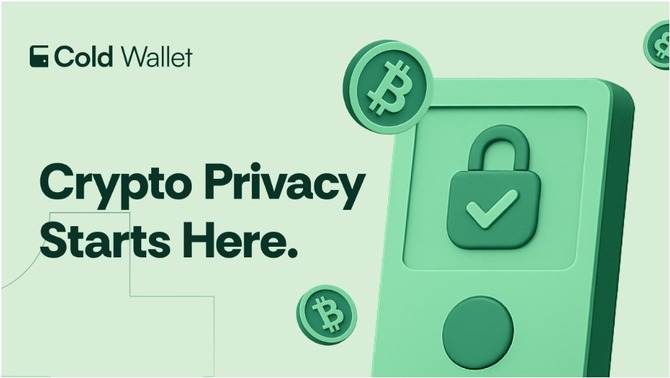Best Cold Wallet for Crypto in 2025: A Practical Guide to Keeping Your Assets Safe

As cryptocurrency adoption continues to grow, so does the importance of protecting your digital wealth. If you’re serious about long-term investment, choosing the best cold wallet for crypto isn’t just a smart move—it’s essential. Online exchanges and hot wallets might offer convenience, but they expose your assets to ongoing digital threats.
A cold wallet takes your private keys offline, drastically reducing the risk of hacks, phishing attempts, or software breaches. In 2025, with increasing cyber threats and regulatory pressure, the safest place for your crypto is in your own hands—and out of the cloud.
This guide breaks down what makes a cold wallet secure, who needs one, and how to choose the right one for your needs.
Why Cold Wallets Matter More Than Ever
Cryptocurrency security isn’t theoretical—it’s tested daily. Major exchanges have collapsed, wallets have been drained through malware, and users have lost life-changing sums due to human error or weak protection.
A cold wallet—also known as cold storage—keeps your private keys completely offline. That means:
-
No internet exposure
-
No background data syncing
-
No real-time tracking or control by third parties
If you plan to hold crypto for the long haul or store a significant amount, the best cold wallet for crypto will keep your assets in your control and away from online risks.
How Cold Wallets Work
At the core of any wallet is a private key. This is the cryptographic proof that you own and can access your digital assets. In hot wallets (like browser extensions or mobile apps), these keys are stored in environments connected to the internet—vulnerable to malware, hacks, or leaks.
Cold wallets remove this risk. Here’s how:
-
Your private key is generated offline and never exposed to the internet.
-
When you want to send crypto, you prepare the transaction on a separate device.
-
The cold wallet signs the transaction offline.
-
You then broadcast the signed transaction to the network via a connected device.
This process keeps your keys completely disconnected from potential attackers.
Who Should Use a Cold Wallet?
The best cold wallet for crypto is especially important for:
-
Long-term holders: If you’re not planning to trade frequently, cold storage keeps your funds safe.
-
Investors with large holdings: The more crypto you own, the greater the risk of becoming a target.
-
Privacy-conscious users: Cold wallets don’t require personal information or centralized registration.
-
Crypto-native businesses: Custodianship and treasury management demand secure storage methods.
If you fall into any of these categories, a cold wallet is more than an option—it’s a necessity.
Top Features to Look for in the Best Cold Wallet for Crypto
Not all cold wallets are created equal. To find the one that fits your needs, look for these qualities:
1. Security Architecture
Choose a device with secure element chips, encrypted firmware, and open-source verification. Top-tier wallets undergo regular audits and updates.
2. Backup and Recovery Options
You should be able to back up your wallet using a secure seed phrase or Shamir backup method. Test recovery before committing large sums.
3. Multi-Currency Support
If you hold more than just Bitcoin, ensure the wallet supports Ethereum, ERC-20 tokens, and other blockchains you use.
4. Intuitive User Interface
A secure wallet should still be usable. The best wallets offer clear setup instructions and user-friendly transaction signing.
5. Portability and Durability
A physical cold wallet should be sturdy enough to survive environmental threats and compact enough to store discreetly.
The Best Cold Wallet for Crypto: Top Picks in 2025
Let’s look at some of the most trusted cold wallets available in 2025:
Ledger Nano X
A Bluetooth-enabled device with support for over 5,000 coins. It’s well-supported, secure, and integrates with Ledger Live for asset tracking.
Trezor Model T
An open-source cold wallet known for its transparency and excellent UX. It supports a wide range of assets and offers strong seed recovery features.
Keystone Pro
Air-gapped, QR-code-based device for maximum isolation. It’s especially popular with privacy-focused users who prefer zero wireless connections.
Ellipal Titan
Another fully air-gapped cold wallet with a metal, tamper-resistant design. It’s user-friendly and works well with mobile apps via QR codes.
Each of these models delivers a balance of security, usability, and flexibility, making them strong contenders for the best cold wallet for crypto in today’s market.
Best Practices When Using a Cold Wallet
Even with the best cold wallet, how you manage it matters. Here are a few essential practices:
-
Never share your seed phrase. Not even with support staff.
-
Store backups in multiple secure places. Think fireproof safes or safety deposit boxes.
-
Test recovery. Practice importing your seed phrase on a different device before transferring large funds.
-
Update firmware regularly. New threats arise, and patches improve protection.
-
Physically secure your device. Theft is a risk if someone gains access to your wallet or backups.
Cold wallets provide strong protection, but they shift responsibility to the user. That’s why best practices matter just as much as your hardware choice.
Conclusion
Choosing the best cold wallet for crypto isn’t about brand loyalty—it’s about finding a secure, reliable, and easy-to-use solution that keeps your digital assets safe for the long term. Whether you’re holding Bitcoin, Ethereum, or a mix of tokens, storing your funds offline removes them from online danger zones.
In 2025, crypto security isn’t optional—it’s foundational. With cold storage, you’re not just storing coins; you’re taking full ownership. And with the right wallet in your pocket or safe, you’re ready for whatever the crypto future brings.







